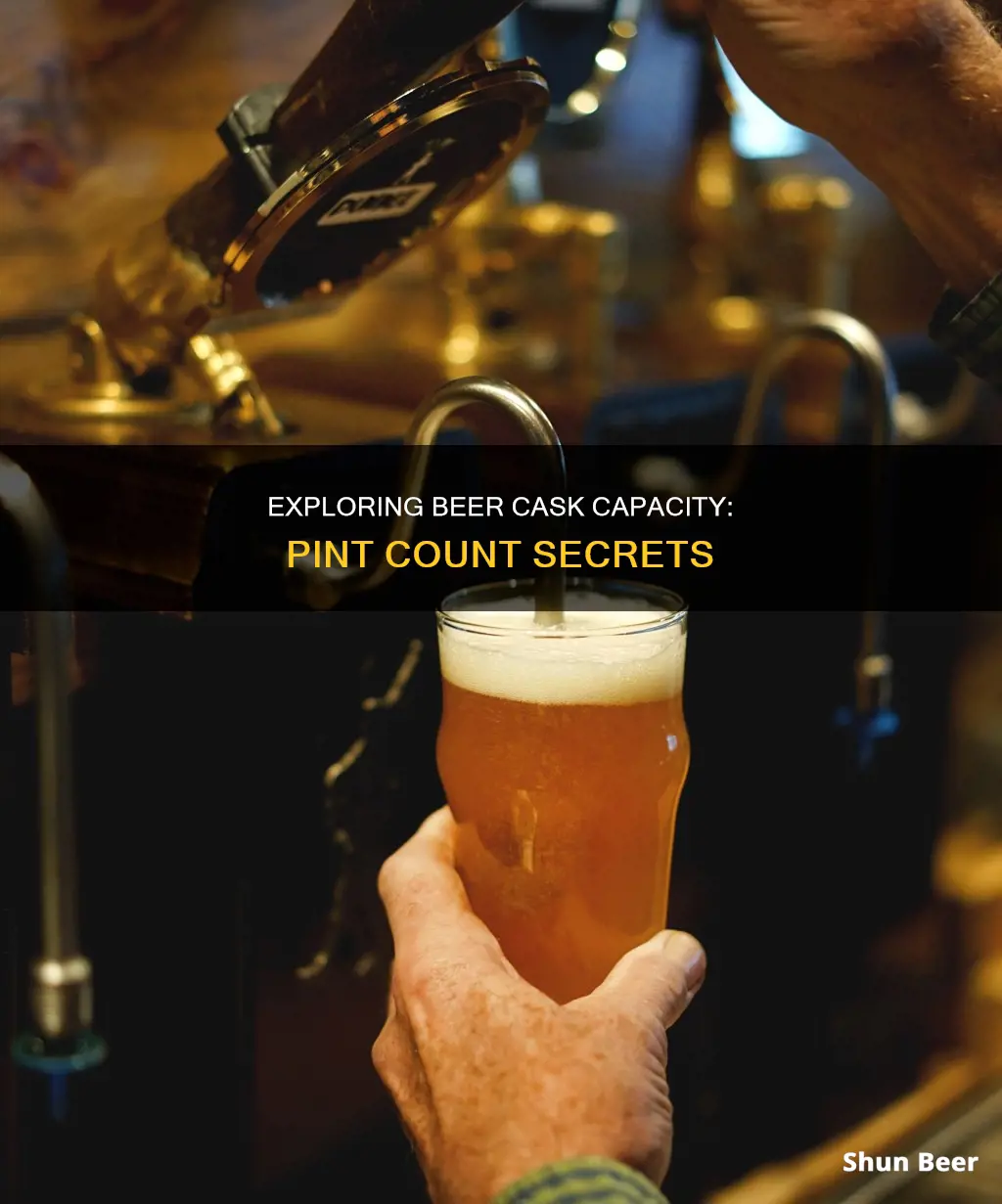
Cask beer, also known as real ale, has been a staple of British pubs for many years. The word 'cask' has evolved to become an overarching term for a container of any size used for cask-conditioned ale, and casks come in a variety of sizes. The number of pints in a cask of beer depends on the size of the cask. A 'pin' cask, for example, holds 36 pints, while a 'firkin' holds 72 pints.
| Characteristics | Values |
|---|---|
| Number of pints in a cask of beer | 72 |
| Other cask sizes | Hogshead (432 pints), Barrel (288 pints), Kilderkin (144 pints), Pin (36 pints) |
What You'll Learn

A cask of beer is typically 72 pints
A firkin is a quarter of a barrel or half a kilderkin. Casks in this size (also called firkins) are the most common container for cask ale.
Cask ale is essentially an unfiltered, unpasteurised ‘live’ product containing yeast that is served from the cask container where it’s gently matured by secondary fermentation. Cask ale is sometimes known as ‘cask-conditioned’ beer due to the vital process it goes through.
Cask beer, real ale in a cask, or whatever you’d like to call it has been around for many years. What sets it apart from many other British draught styles (such as filtered keg beer) is that cask beer contains live yeast. When handled correctly, this yeast creates a natural carbonation (or “secondary fermentation”) within the drink; this simply means that the beer gets the chance to taste its absolute best! Cask beer treats you to a much smoother mouthfeel compared to something like a carbonated keg, and there’s a reason it’s a staple of British pubs.
Casks were the predominant way of storing and moving beer from the brewery to its location before metal kegs were introduced in the 1950s. In fact, breweries such as Joseph Holt had their own skilled cask-makers, known as coopers, who were still active at their brewery up until the mid-1980s.
Beer Measurement: Bar Precision in a Pint
You may want to see also

A firkin is a quarter of a barrel and contains 72 pints
The firkin is a small wooden vessel or cask, derived from the Middle English 'ferdekyn' and Middle Dutch diminutive of 'vierde', meaning 'fourth'. Its use dates back to the 14th century.
In the context of beer, a firkin is a cask ale, and it is the most common container for this type of beer. While the exact volume of a firkin has varied over time, it is currently standardised at 9 imperial gallons or 40.91 litres. This is equivalent to 72 pints, although it is important to note that not all of the beer in a firkin is consumable due to sediment, finings, and other factors.
The firkin is a popular choice for cask ale due to its convenient size, and it is often used for small gatherings or parties. It is also a common unit of measurement for butter and cheese, with a standard weight of 56 pounds or 25 kilograms.
Beer Pint Size in NZ: How Much Does It Hold?
You may want to see also

A hogshead is a large cask, holding 432 pints
The number of pints in a cask of beer depends on the size of the cask. A "cask of beer" can refer to various sizes of casks, from small containers to large casks.
Historically, the capacity of a hogshead was standardised differently according to the liquid it contained. For instance, a hogshead of wine was standardised at 46 imperial gallons of claret or Madeira, 57 imperial gallons of port, and 54 imperial gallons of sherry. Similarly, a hogshead of brandy was approximately 56 to 61 gallons, while a hogshead of beer or ale was 54 gallons.
In the United States, a hogshead is a unit of liquid measurement equal to 63 gallons or 238 litres. In Britain, a hogshead contains about 300 litres or 66 imperial gallons.
Exploring Beer and Mead: What Sets Them Apart?
You may want to see also

A barrel holds 288 pints
Historically, the capacity of brewery casks was measured and standardised according to a specific system of English units. The system was originally based on the ale gallon of 282 cubic inches (4.62 litres; 1.22 US gallons). In the United Kingdom and its colonies, the adoption of the imperial system in 1824 led to a redefinition of the units in terms of the slightly smaller imperial gallon (1.2 US gallons; 4.5 litres).
The barrel of beer or ale was equal to two kilderkins or 2/3 of a beer or ale hogshead. This is somewhat larger than a wine barrel. Over time, the ale barrel underwent various redefinitions. Initially, it was defined as 32 ale or beer gallons (147.9 litres), but this changed to 34 ale or beer gallons (157.1 litres) in 1688 and then to 36 ale or beer gallons (166.4 litres) in 1803. With the adoption of the imperial system, the beer or ale barrel was redefined as 36 imperial gallons, or approximately 163.659 litres.
The hogshead, which is larger than a barrel, also underwent changes in its volume. In the mid-15th century, the ale hogshead was defined as 48 ale or beer gallons (221.8 litres). In 1688, it was redefined as 51 ale or beer gallons (235.7 litres), and in 1803, it was again redefined as 54 ale or beer gallons (249.5 litres), equivalent to the beer hogshead. With the adoption of the imperial system in 1824, the ale or beer hogshead was standardised as 54 imperial gallons, or approximately 245.48886 litres.
Filtered vs Unfiltered Beer: What's the Difference?
You may want to see also

A kilderkin holds 144 pints
A kilderkin is a unit of capacity in the English system of measurement. It is derived from the Middle Dutch word "kindekijn", meaning "quarter tun", and is equivalent to half a barrel or two firkins. In the modern imperial system, a kilderkin is defined as 18 imperial gallons or approximately 2.89 cubic feet.
Historically, the term "kilderkin" was used for a different quantity, containing 16 ale or beer gallons. This amount was redefined in 1688 to 17 ale or beer gallons and again in 1803 to 18 ale or beer gallons. With the adoption of the imperial system in 1824, the kilderkin was standardised to 18 imperial gallons.
A kilderkin is also equivalent to 144 pints. However, it is important to note that a kilderkin of cask-conditioned beer will not yield 144 consumable pints due to the presence of sediment, finings, beer stone, hops, and proteins. Therefore, while a kilderkin is a useful unit of measurement for accounting purposes, the actual amount of consumable beer may vary.
The kilderkin is still used today by CAMRA, the Campaign for Real Ale, for calculating beer quantities at UK beer festivals. It is a convenient unit for internal accounting, as all drinks (except wine) are sold in pints or parts of a pint.
Malt Beverage vs Beer: What's the Difference?
You may want to see also







